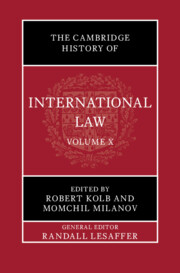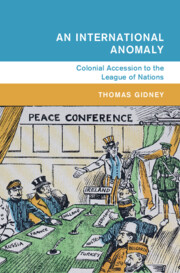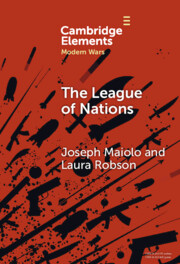Refine search
Actions for selected content:
170 results
11 - Pearl Harbor
- from Part III - The Twentieth Century through World War II
-
- Book:
- Crises, War, and Diplomacy
- Published online:
- 07 November 2025
- Print publication:
- 20 November 2025, pp 210-240
-
- Chapter
- Export citation
2 - Henry Strakosch and Reconstruction
-
- Book:
- The City's Defense
- Published online:
- 09 October 2025
- Print publication:
- 23 October 2025, pp 66-102
-
- Chapter
- Export citation
5 - Towards an Urban Internationalism?
-
-
- Book:
- International Organizations Engaging the World
- Published online:
- 09 October 2025
- Print publication:
- 23 October 2025, pp 84-100
-
- Chapter
-
- You have access
- Open access
- HTML
- Export citation
When criminalisation fails in global politics: Piracy’s unsuccessful recognition as an international crime
-
- Journal:
- Review of International Studies , First View
- Published online by Cambridge University Press:
- 20 October 2025, pp. 1-20
-
- Article
-
- You have access
- Open access
- HTML
- Export citation
In the name of nature: Making the League of Nations, the International Rights of Nature Tribunal and international law
-
- Journal:
- Leiden Journal of International Law , First View
- Published online by Cambridge University Press:
- 15 August 2025, pp. 1-22
-
- Article
-
- You have access
- Open access
- HTML
- Export citation
The Right to Banality: Interwar Jewish Global Thought between Eastern Europe and the Middle East
-
- Journal:
- Nationalities Papers , FirstView
- Published online by Cambridge University Press:
- 01 August 2025, pp. 1-23
-
- Article
-
- You have access
- Open access
- HTML
- Export citation
1 - The Jewish World under Nazi Impact, 1930–1939
-
-
- Book:
- The Cambridge History of the Holocaust
- Published online:
- 16 May 2025
- Print publication:
- 12 June 2025, pp 24-37
-
- Chapter
- Export citation
2 - The League of Nations and the Global Legal Order
-
-
- Book:
- The Cambridge History of International Law
- Published online:
- 01 May 2025
- Print publication:
- 29 May 2025, pp 41-67
-
- Chapter
- Export citation
4 - The League of Nations as an International Organisation
-
-
- Book:
- The Cambridge History of International Law
- Published online:
- 01 May 2025
- Print publication:
- 29 May 2025, pp 100-129
-
- Chapter
- Export citation
4 - Imperial Social Medicine in Southeast Asia
-
-
- Book:
- Medicine on a Larger Scale
- Published online:
- 05 May 2025
- Print publication:
- 22 May 2025, pp 81-105
-
- Chapter
-
- You have access
- Open access
- HTML
- Export citation
The Pacific Route: Brazil, Japan, the Paris Peace Conference, and the Meanings of Racial Equality
-
- Journal:
- Comparative Studies in Society and History / Volume 67 / Issue 3 / July 2025
- Published online by Cambridge University Press:
- 13 May 2025, pp. 570-594
-
- Article
-
- You have access
- Open access
- HTML
- Export citation

The Cambridge History of International Law
-
- Published online:
- 01 May 2025
- Print publication:
- 29 May 2025
9 - Placeholders
- from Structures, Spaces, and Jurisdictions
-
-
- Book:
- Ways of Seeing International Organisations
- Published online:
- 17 April 2025
- Print publication:
- 24 April 2025, pp 166-184
-
- Chapter
-
- You have access
- Open access
- HTML
- Export citation
15 - A White Knight in Shining Armour? Ethiopia, International Organisations, and the Global Colour Line
- from Capital, Class, and Political Economy
-
-
- Book:
- Ways of Seeing International Organisations
- Published online:
- 17 April 2025
- Print publication:
- 24 April 2025, pp 291-308
-
- Chapter
-
- You have access
- Open access
- HTML
- Export citation
3 - Inter Se and the League of Nations
-
- Book:
- An International Anomaly
- Published online:
- 23 March 2025
- Print publication:
- 03 April 2025, pp 105-124
-
- Chapter
-
- You have access
- Open access
- HTML
- Export citation
Introduction
-
- Book:
- An International Anomaly
- Published online:
- 23 March 2025
- Print publication:
- 03 April 2025, pp 1-24
-
- Chapter
-
- You have access
- Open access
- HTML
- Export citation

An International Anomaly
- Colonial Accession to the League of Nations
-
- Published online:
- 23 March 2025
- Print publication:
- 03 April 2025
-
- Book
-
- You have access
- Open access
- Export citation

The League of Nations
-
- Published online:
- 20 February 2025
- Print publication:
- 20 February 2025
-
- Element
-
- You have access
- Open access
- HTML
- Export citation
2 - Great Power Management, International Organizations, and the Promotion of Peaceful Change: 1815 to the Present
- from Part II - Theory
-
-
- Book:
- International Organizations and Peaceful Change in World Politics
- Published online:
- 30 January 2025
- Print publication:
- 06 February 2025, pp 31-54
-
- Chapter
- Export citation
The Birth of East-Belgian Identity and the Treaty of Versailles: A Critical Legal Analysis
-
- Journal:
- Nationalities Papers / Volume 53 / Issue 5 / September 2025
- Published online by Cambridge University Press:
- 10 January 2025, pp. 1099-1116
-
- Article
-
- You have access
- Open access
- HTML
- Export citation
